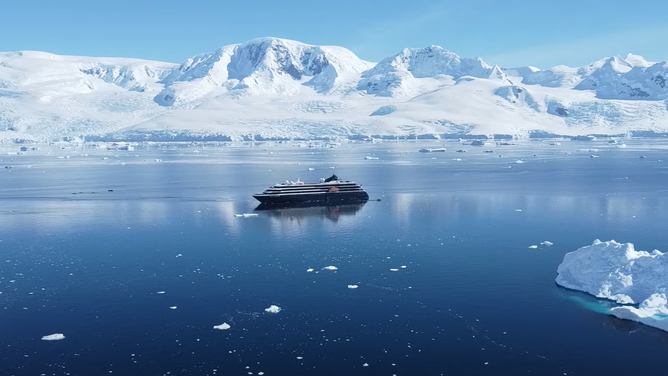Antarctic's extreme weather drawing more cruise ship expeditions
The typical Antarctica tourism season begins in late October or early November, and cruises can run through mid-March.
Melting Antarctica ice shelf drawing cruise ship expeditions
Earth’s least-populated continent is growing in popularity that travel experts say wouldn’t be possible without advancements in the cruise industry.
Earth’s least-populated continent is growing in popularity which travel experts said wouldn’t be possible without advancements in the cruise industry.
Atlas Ocean Voyages is one of the latest companies to announce excursions on multiday trips to Antarctica, where weather conditions are known to be extreme.
"This waterway is where (the) cold Southern Ocean meets warm northern seawater (and) creates powerful currents that can sometime(s) deliver churning seas," a company representative said. "It can be exciting, to say the least."
According to Australian record keeping, the yearly temperature is only about 14 degrees Fahrenheit along the coast, but on the higher terrain, temperatures are commonly well below 0.
In fact, Vostok Research Station holds the world record of being the coldest place on Earth, with a record temperature of -128.56 degrees being set on July 21, 1983.
Despite the cold air, scientists said the climate is changing, and that has impacts not only for the world but also for witnesses who are fortunate to see the relatively dry terrain up close.
ANTARCTICA’S ‘DOOMSDAY GLACIER’ IS MELTING AWAY DIFFERENTLY THAN SCIENTISTS FIRST THOUGHT
Industry insiders said advancements in shipbuilding are allowing for safer excursions into waters that at one time may have been covered in ice.
Assessments by NASA and the European Space Agency estimate the land mass is losing some 150 billion tons of ice annually, creating possible hazards in nearby seas.
Atlas Ocean Voyages said its cruises easily navigate through regions such as the Drake Passage and Lemaire Channel, which provide breathtaking views of monumental ice cliffs.
"As the weather conditions can be unpredictable and change, multiple days on a voyage are the captain’s choice to maximize the time and take guests to the best areas for wildlife viewing," an Atlas Ocean Voyages representative said.
According to the International Association of Antarctica Tour Operators, which is made up of companies such as Norwegian Cruise Lines, Celebrity Cruise Lines, Atlas Ocean Voyages and others, about 40,000 people visit the continent annually on expeditions.
The typical Antarctica tourism season begins in late October or early November, and cruises can run through mid-March.
During a typical excursion, species of penguins, humpback whales and hourglass dolphins, elephant seals and birds are common sights.
WHAT ARE ICEBERGS? COLD HARD FACTS ABOUT THESE MASSIVE ICE CHUNKS

Melting Antarctica ice shelf drawing cruise ship expeditions
(Atlas Ocean Voyages / FOX Weather)
Icebergs have historically been problematic for cruise liners around the globe. The Titanic sank in 1912 after striking a chunk of ice in the North Atlantic Ocean. Of the roughly 2,200 passengers and crew on board, about 700 survived. Last year, a Norwegian Cruise Line ship filled with passengers was damaged while in transit to Hubbard Glacier in Alaska.
Multiple agencies, such as the International Ice Patrol and the U.S. National Ice Center, regularly monitor and provide updates to the maritime community, but not all features are trackable. Ultimately, it is up to the ship’s technology and ice detection systems to avoid icebergs.
In order to keep the environment as pristine as possible, operators must notify home governments of their intentions and provide detailed environmental impact assessments. Additionally, ships are required to burn lighter-grade fuels while in the Antarctic Treaty Area.
